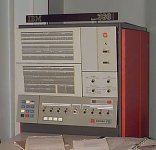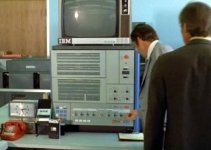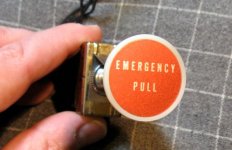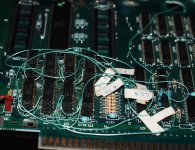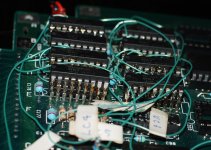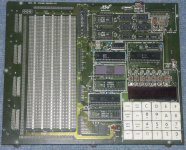256K memory.
Two floppy drives.
No hard disk.
Amber monitor.
10Mhz.
If it's from 1986 it's cool. Mine was 1 MEG of memory but only one 1.2 meg floppy. If you're still using it, I'm SO sorry.
G²
You guys are young. 
My first PC was the Commodore "PET". The daddy of the 64. Only cassette drive, no floppy or HDD. 14K ROM, 1Mhz speed. Circa 1979. Others in the computer club at the time had the Apple-II or the "Trash-80".
Mine did not have the built in cassette.
My first PC was the Commodore "PET". The daddy of the 64. Only cassette drive, no floppy or HDD. 14K ROM, 1Mhz speed. Circa 1979. Others in the computer club at the time had the Apple-II or the "Trash-80".
An externally hosted image should be here but it was not working when we last tested it.
Mine did not have the built in cassette.
Sperry PC:
2 x 360Kb floppies, 5 MB harddrive, green screen, Epson FX 80 printer 640K memory running at 8 Mhz...
Man, they were flying compared to those old IBM's...
Assembled the whole consignment for our IT division (10 of them) with a Philips screwdriver and the open manual... (on the memory boards I had to install all those memory chips by hand!!! )
2 x 360Kb floppies, 5 MB harddrive, green screen, Epson FX 80 printer 640K memory running at 8 Mhz...
Man, they were flying compared to those old IBM's...
Assembled the whole consignment for our IT division (10 of them) with a Philips screwdriver and the open manual... (on the memory boards I had to install all those memory chips by hand!!! )
Ibm 360
My first computer, though not my "personal" computer except when I had to toggle in a patch
When a program was running the lights on the front panel would flash for each instruction processed, so it's quite funny to see an old movie where everybody is hovering around the computer and not a single light is on
The red button on the top right of the panel was an emergency stop. At one place I worked, one of the operators thought it was a fake switch and pulled it. Everything shut down and IBM had to come in and reset the whole computer. Needless to say, the operator's experiment cost him his job...
My first computer, though not my "personal" computer except when I had to toggle in a patch
When a program was running the lights on the front panel would flash for each instruction processed, so it's quite funny to see an old movie where everybody is hovering around the computer and not a single light is on
The red button on the top right of the panel was an emergency stop. At one place I worked, one of the operators thought it was a fake switch and pulled it. Everything shut down and IBM had to come in and reset the whole computer. Needless to say, the operator's experiment cost him his job...
Attachments
You guys are young.
My first PC was the Commodore "PET". The daddy of the 64. Only cassette drive, no floppy or HDD. 14K ROM, 1Mhz speed. Circa 1979. Others in the computer club at the time had the Apple-II or the "Trash-80".
Mine did not have the built in cassette.
Oh, my first _computer_. That was an Apple ][ Plus. By the time I abandoned it, it consumed around $6000 in 1980 dollars. Graphics printer card $300. 80 column card $300. NEC dot matrix printer $750. RAM disc cards $400. Green screen monitor $250. Dual floppies $1000. Clock, sweet talker, programmable keyboard interface, RS-232 interface, Apple Pascal, language card. Blank Maxell floppies - 143K Bytes - $57.50 / 10. You had to be dedicated and a little crazy. BTW before I got the floppy drives it worked very well with the Nakamichi 580M cassette machine. Still have the Nak.
Current PC - 4GB RAM, 1.5 T drive, SPDIF, FireWire, Esata, 7.1 audio, DVI-D / HDMI blah blah blah - like many others. <$500 in 2009. Aren't computers grand?
G²
OOO! That brought back SOME memories of my days a computer operator:
The insurance company I worked for had a ICT Orion computer that still had transistors. ( A relic from the mid 60's still running strong up untill some time 1976) Input was with punched cards or paper tape. No comms to anywhere... 16 tape decks using 1 inch wide mag tapes. 32K memory, and drum memory/space. Drum was the precursor to disk... 2 x 2500 lpm (lines per minute) barrel printers sang to us once they started printing to I-line...
The console also looked like a cross between the control room of nuclear power station and a telephone exchange.
Control to the "beast" was thru a Flexowriter console, and the console log was output to punched paper tape...
Yea, those were the days of long hair and weird habits. Now we don't have the hair, and the domesticated husbands' habits align with that of their wives...
The insurance company I worked for had a ICT Orion computer that still had transistors. ( A relic from the mid 60's still running strong up untill some time 1976) Input was with punched cards or paper tape. No comms to anywhere... 16 tape decks using 1 inch wide mag tapes. 32K memory, and drum memory/space. Drum was the precursor to disk... 2 x 2500 lpm (lines per minute) barrel printers sang to us once they started printing to I-line...
The console also looked like a cross between the control room of nuclear power station and a telephone exchange.
Control to the "beast" was thru a Flexowriter console, and the console log was output to punched paper tape...
Yea, those were the days of long hair and weird habits. Now we don't have the hair, and the domesticated husbands' habits align with that of their wives...
My first one:
Motorola Evaluation Kit 6800D2 bought in 1977 consisting of:
- CPU Motorola 6800 running at 1 MHz
- 2×128 Byte 6810
- 1 KByte ROM 6830 holding the operating system
- 6 * 7-Segment-Display
- Hexadezimal keyboard 0-9 and A-F
- External cassette using Kansas City Standard interface
My first step into the digital world.
Best regards - Rudi_Ratlos
An externally hosted image should be here but it was not working when we last tested it.
Motorola Evaluation Kit 6800D2 bought in 1977 consisting of:
- CPU Motorola 6800 running at 1 MHz
- 2×128 Byte 6810
- 1 KByte ROM 6830 holding the operating system
- 6 * 7-Segment-Display
- Hexadezimal keyboard 0-9 and A-F
- External cassette using Kansas City Standard interface
My first step into the digital world.
Best regards - Rudi_Ratlos
I guess a commodore 64 with dataset (cassette) although it was the family pc was my first PC. An Amiga 1000 with 512K Memory was the first I bought myself, and I even did the DIY 512MB ram upgrade which entailed soldering ram chips on top of the ones on the motherboard, cutting pins and running wires to other places 
Fujitsu M180 II AD was the first commercial (mainframe) computer I used, when I was a computer operator
Tony.
Fujitsu M180 II AD was the first commercial (mainframe) computer I used, when I was a computer operator
Tony.
Here are some pics of the above mentioned ram upgrade 
and the link has three photos of a fujitsu M380A Mainframe CPU board (one of 16 that made up the central processor) I grabbed one when they decommisioned it for scrap. These boards cost $28K AU in 1992 if you needed to buy a spare.... Flickr: Search _wintermute's photostream
My Boss at the time had one from the M180 II AD that I first worked on, which was much smaller, but had supposedly had solid gold heatsinks!
Tony.
and the link has three photos of a fujitsu M380A Mainframe CPU board (one of 16 that made up the central processor) I grabbed one when they decommisioned it for scrap. These boards cost $28K AU in 1992 if you needed to buy a spare.... Flickr: Search _wintermute's photostream
My Boss at the time had one from the M180 II AD that I first worked on, which was much smaller, but had supposedly had solid gold heatsinks!
Tony.
Attachments
The first computer I used was one of these: Bendix-G15-1950s. Needless to say, personal computer was an Oxymoron at the time, especially for high School students.
Then I spent some time with these: The CDC 6000 Series Computer
Then, after collage, I worked with these: http://mit-a.com/Images/big/IV-90%20chassis%202.JPG.
Actually I was in the small group that designed the machines. I built several of the prototype cards for these using wirewrap and lots of sockets.
I then got a small PC based on the s100 bus called a GNAT. I still have an s100 based system I use regularly. This impedance analyzer ESI 2160 Video Bridge (Auto LCR Meter) is based on a Z80 and the S100 backplane.
Computers were really boring at the time. I ditched a paying job and started building audio stuff to regain some sanity. Computers have come a very long way since. However the construction quality has deteriorated. But in fairness the cost of one of the Bendix tube modules would be more than a modern decent PC in inflation adjusted dollars.
Then I spent some time with these: The CDC 6000 Series Computer
Then, after collage, I worked with these: http://mit-a.com/Images/big/IV-90%20chassis%202.JPG.
Actually I was in the small group that designed the machines. I built several of the prototype cards for these using wirewrap and lots of sockets.
I then got a small PC based on the s100 bus called a GNAT. I still have an s100 based system I use regularly. This impedance analyzer ESI 2160 Video Bridge (Auto LCR Meter) is based on a Z80 and the S100 backplane.
Computers were really boring at the time. I ditched a paying job and started building audio stuff to regain some sanity. Computers have come a very long way since. However the construction quality has deteriorated. But in fairness the cost of one of the Bendix tube modules would be more than a modern decent PC in inflation adjusted dollars.
Intel SDK-85. My dad brought one home from work for me I think in 1982 because, in the 6th grade, there was this book in our middle school library called "Build You Own Robot" that was based on the 8085 CPU. So, that's how I learned to program - assembling 8085 opcodes by hand using the manual. Soon thereafter, I got to use a PDP-11/70 running Unix V7 (AT&T real stuff) on a timeshare host after school. In the late 80's, I got a courtesy dialup account to a VAX 11/750 using my ultra-hip 2400 baud modem.
In college, I had PC/XT clone running Wordstar and used to dial into the Universities' VAXCluster. I learned about USENET News in 1991 by using the 'field'/'service' username-password pair that shipped out of the box on Ultrix-32. I used to login (without authorization!) to the sparse few VAXen running Ultrix on campus - at night, when the grad students had gone home, and used the 'rn' program to read the usenet groups.
Around 1993, I was gifted a Sun 3/80 with a nice monitor which I used for many years, until 1998 or so at home. In 1999, I spent money and built a dual Pentium II box running some flavour of Linux at the time (probably not Redhat).
At work, I used all SGI boxes up until 1995. Then DECStations for a few years. Around 1998 till 2008 - I used SPARC boxes at work. I hated SPARC boxes, they were always much slower than the other vendor's alternatives (especially the DEC Alpha's, which my colleagues had and were significantly faster.)
-- Jim
In college, I had PC/XT clone running Wordstar and used to dial into the Universities' VAXCluster. I learned about USENET News in 1991 by using the 'field'/'service' username-password pair that shipped out of the box on Ultrix-32. I used to login (without authorization!) to the sparse few VAXen running Ultrix on campus - at night, when the grad students had gone home, and used the 'rn' program to read the usenet groups.
Around 1993, I was gifted a Sun 3/80 with a nice monitor which I used for many years, until 1998 or so at home. In 1999, I spent money and built a dual Pentium II box running some flavour of Linux at the time (probably not Redhat).
At work, I used all SGI boxes up until 1995. Then DECStations for a few years. Around 1998 till 2008 - I used SPARC boxes at work. I hated SPARC boxes, they were always much slower than the other vendor's alternatives (especially the DEC Alpha's, which my colleagues had and were significantly faster.)
-- Jim
Attachments
I tried to build some sort of analog computer that used potentiometers. Then a sort of digital one that used DPDT switches made from paper clips and thumbtacks. Then, a keypunch to write programs on punch cards which the teacher took to the university once a week to run. It took a while to debug programs.
Then a MicroProfessor Z80 trainer, and finally a real personal computer: a "Unitron" Apple II+ clone. At least that was the main board; the case I made from 3/4" plywood, the power supply (initially) used a Radio Shack transformer and a 78H05 regulator. Keyboard was surplus, but had a compatible encoder chip, although it didn't do the arrow keys or even backspace. Storage was to a portable cassette player. Helpfully, I bought an official Apple II technical manual which had schematics and even assembly language for the EPROMs. Later, I bought a surplus Shugart SA400 and made an adapter board. The floppy controller card, 80 column, Z80, EPROM burner, and other cards were bought as bare boards. Obtaining PROMs for an RGB card was a problem: I reverse engineered it to get a schematic, then figured out how to program a portion of the PROM (enough to get text working). To burn the bipolar PROM, I added some driver chips to the Microprofessor and wrote a little program to do the burning.
My first PC (4.77MHz 8088), I bought a bare motherboard and bags of parts. It never worked that well, possibly since it wasn't a multilayer board. Irritatingly, my friend built the exact same board and had no problems. I partly tamed the parity errors by adding a ground plane under the board using a sheet of plastic and aluminum foil. Horrible Remex 2/3 height floppy drives were another brilliant purchase. Video and other I/O cards were built up from bare (unstuffed, not prototype) boards. Around 1986, I scored a used Turbo XT (8 MHz!) for about $125. Two surplus full-height 10MB MFM CMI harddrives for $125 each. WD MFM controller was around $175. (At the time, a no-name turbo XT with 20M Seagate ST225 and a CGA monitor cost $2000.)Then a 6 MHz AT clone which had been temporarily killed by a failed 80287 (but recovered). Then an overclocked no-name 20 MHz 286 board for about $400. Then for the first time, a near SOTA CPU: 33MHz 486 Gigabyte motherboard (thanks to a friend unexpectedly repaying a loan) (at the time, that was worth $1500 or so). It initially seemed like an unimaginably powerful machine, with a staggering 8 megabytes of RAM.
I'm going to reassemble that 486 eventually. It'll be pimped out with a Gravis Ultrasound, and a Copy II PC Option board. Probably a 120M Seagate hard drive (my first IDE drive), but hopefully also a CF drive to facilitate moving data on and off. If not, a SCSI card and CD writer. The Option Board enables reading Apple II discs, so in theory I can make backups and run them in an emulator.
As far as sound goes... Wolfenstein on the Apple II managed to play voices and sound effects over the stock 1-bit output. My DIY case did have a larger than normal 4" speaker, which was a vast improvement on the speakers in normal computer cases (and even had a volume control - a series resistor and a switch to short it). I built a sound card for the Apple II that used an 8 bit DAC; not much software supported it, but there were apps for a speech synthesizer which was fun. The first real sound card was an 8 bit (mono) Soundblaster. It cost about $175 in the early '90s.
Then a MicroProfessor Z80 trainer, and finally a real personal computer: a "Unitron" Apple II+ clone. At least that was the main board; the case I made from 3/4" plywood, the power supply (initially) used a Radio Shack transformer and a 78H05 regulator. Keyboard was surplus, but had a compatible encoder chip, although it didn't do the arrow keys or even backspace. Storage was to a portable cassette player. Helpfully, I bought an official Apple II technical manual which had schematics and even assembly language for the EPROMs. Later, I bought a surplus Shugart SA400 and made an adapter board. The floppy controller card, 80 column, Z80, EPROM burner, and other cards were bought as bare boards. Obtaining PROMs for an RGB card was a problem: I reverse engineered it to get a schematic, then figured out how to program a portion of the PROM (enough to get text working). To burn the bipolar PROM, I added some driver chips to the Microprofessor and wrote a little program to do the burning.
My first PC (4.77MHz 8088), I bought a bare motherboard and bags of parts. It never worked that well, possibly since it wasn't a multilayer board. Irritatingly, my friend built the exact same board and had no problems. I partly tamed the parity errors by adding a ground plane under the board using a sheet of plastic and aluminum foil. Horrible Remex 2/3 height floppy drives were another brilliant purchase. Video and other I/O cards were built up from bare (unstuffed, not prototype) boards. Around 1986, I scored a used Turbo XT (8 MHz!) for about $125. Two surplus full-height 10MB MFM CMI harddrives for $125 each. WD MFM controller was around $175. (At the time, a no-name turbo XT with 20M Seagate ST225 and a CGA monitor cost $2000.)Then a 6 MHz AT clone which had been temporarily killed by a failed 80287 (but recovered). Then an overclocked no-name 20 MHz 286 board for about $400. Then for the first time, a near SOTA CPU: 33MHz 486 Gigabyte motherboard (thanks to a friend unexpectedly repaying a loan) (at the time, that was worth $1500 or so). It initially seemed like an unimaginably powerful machine, with a staggering 8 megabytes of RAM.
I'm going to reassemble that 486 eventually. It'll be pimped out with a Gravis Ultrasound, and a Copy II PC Option board. Probably a 120M Seagate hard drive (my first IDE drive), but hopefully also a CF drive to facilitate moving data on and off. If not, a SCSI card and CD writer. The Option Board enables reading Apple II discs, so in theory I can make backups and run them in an emulator.
As far as sound goes... Wolfenstein on the Apple II managed to play voices and sound effects over the stock 1-bit output. My DIY case did have a larger than normal 4" speaker, which was a vast improvement on the speakers in normal computer cases (and even had a volume control - a series resistor and a switch to short it). I built a sound card for the Apple II that used an 8 bit DAC; not much software supported it, but there were apps for a speech synthesizer which was fun. The first real sound card was an 8 bit (mono) Soundblaster. It cost about $175 in the early '90s.
Last edited:
My first venture into microprocessors was a Microprofessor.
Looking back it was incredibly basic having to type in hex codes for the instructions. However, I did manage to write a simple game for it using the push buttons and LED displays.
What a step up it was later on to get a Sinclair Spectrum and a Z80 editor/assembler.
The next system we got was a multi board computer system.
I wrote an editor and Z80 assembler for it on teh Spectrum and used that for development for a few years before my first pc landed on the desk.
The first pc was a 10MHz beast with no hard disc but two floppies and an amber monitor. It still boots up faster than my current PC !
Looking back it was incredibly basic having to type in hex codes for the instructions. However, I did manage to write a simple game for it using the push buttons and LED displays.
What a step up it was later on to get a Sinclair Spectrum and a Z80 editor/assembler.
The next system we got was a multi board computer system.
I wrote an editor and Z80 assembler for it on teh Spectrum and used that for development for a few years before my first pc landed on the desk.
The first pc was a 10MHz beast with no hard disc but two floppies and an amber monitor. It still boots up faster than my current PC !
- Status
- This old topic is closed. If you want to reopen this topic, contact a moderator using the "Report Post" button.
- Home
- Source & Line
- PC Based
- My first PC.
